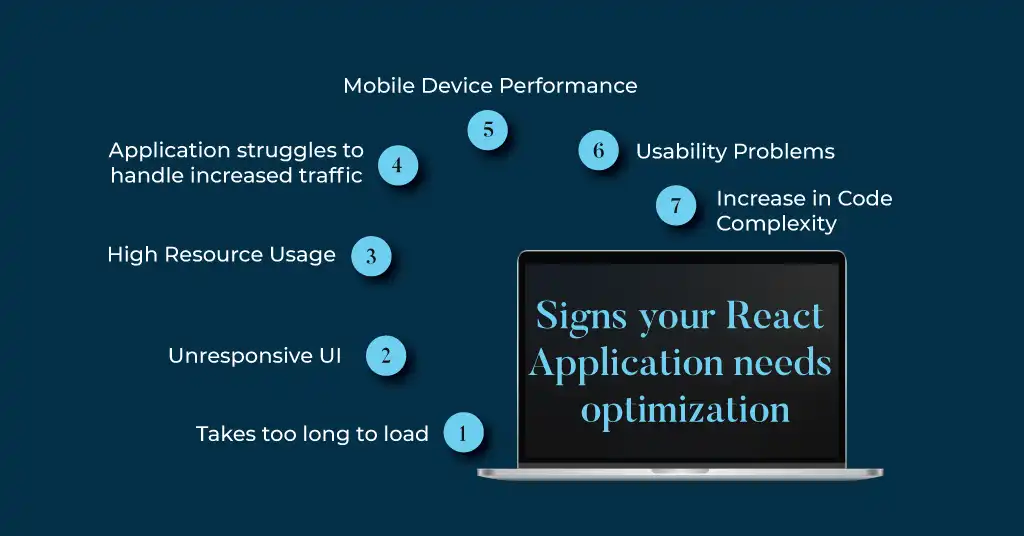Ever felt like your existing application could use a boost?
It’s a common thought among businesses, especially in the fast-paced world of application development where every little improvement counts.
In the case of React, where speed is key, optimizing your app isn’t just a good idea – it’s crucial for making sure users have a smooth experience.
But when should you think about optimizing your React app, and how do you go about it?
In this blog, we’ll answer those questions and give you practical tips and techniques for React App performance optimization to make it faster and more user-friendly.
So, Let’s take a deep dive in – but before that let’s understand what optimization actually is?
What is Application Optimization?
Optimization of applications is the practice of fine-tuning and refining software to make it run faster, consume fewer resources, and provide a smoother experience for users.
It involves identifying areas where the application may be slow or inefficient and implementing strategies to improve its performance.
This can include –
- Optimizing Algorithms
- Minimizing Code Complexity
- Reducing Network Latency
- Leveraging Caching Mechanisms
- Employing Efficient Data Storage Methods
The goal of optimizing an application is to enhance the overall efficiency and responsiveness of the application, ultimately resulting in better user satisfaction and engagement!
But then a question arises!
If React applications are known to provide advanced features with fewer headaches, why do these applications need to be optimized?
Well, the answer to this question is pretty simple – There is no such application ever made that doesn’t require optimization!
When asked to a React Expert at Covrize –Dipti Agravat she said –
“Despite React’s advanced features, optimization is crucial. Every application, no matter how well-designed, benefits from fine-tuning for better performance and user experience. Moreover, as applications evolve and grow over time, optimization becomes increasingly essential to maintain efficiency and meet growing demands.”
Why React Applications Need Optimization?
React applications require optimization due to several challenges unique to their architecture and the expectations of modern web users –
1) Complexity – React applications often consist of numerous components with complex interactions. As the application grows in complexity, it becomes prone to performance bottlenecks, resulting in slower load times and reduced responsiveness.
2) Virtual DOM – While React’s virtual DOM offers performance benefits, inefficient use of components or excessive re-renders can impact application performance. Without optimization, React applications may struggle to efficiently manage updates and render the user interface.
3) State Management – React’s state management can become unwieldy, especially in large-scale applications with numerous components sharing state. Inefficient state management can lead to unnecessary re-renders and decreased application performance.
4) Network Requests – React applications often rely on network requests to fetch data from servers or APIs. Inefficient data fetching techniques, such as making too many or unnecessary requests, can degrade application performance and increase load times.
5) Mobile Optimization – With the increasing prevalence of mobile devices, optimizing React applications for mobile platforms is essential. Unoptimized React applications may consume excessive resources on mobile devices, leading to slower performance and draining battery life.
6) User Expectations – Modern web users have high expectations for application performance and responsiveness. Slow-loading or unresponsive React applications can result in poor user experience, leading to decreased user engagement and retention.
By addressing these challenges through optimization, React applications can deliver a smoother, more enjoyable experience to ensure that applications meet the demands of modern web users.
Now you must be thinking how could one tell that the application might need optimization?
Let’s explore some signals in the section below –
When does an existing React application need optimization?

There are certain indications that a React application might need optimization –
1) Slow Load Times – If the application takes too long to load, it may indicate inefficiencies that can be addressed through optimization.
2) Unresponsive UI – When user interactions result in lag or delays, it suggests that the application’s performance could be improved.
3) High Resource Usage – Excessive consumption of system resources such as CPU, memory, or network bandwidth may signal the need for optimization to reduce resource usage.
4) Scalability Issues – If the application struggles to handle increased traffic or data volume, optimization may be necessary to ensure smooth operation under heavy loads.
5) Mobile Device Performance – Poor performance on mobile devices, such as slow load times or high battery consumption, indicates the need for optimization to improve the mobile user experience.
6) Usability Problems – User complaints about navigation difficulties, complex interfaces, or other usability issues may indicate areas where optimization can enhance the user experience.
7) Development Challenges – If the development process becomes increasingly difficult due to code complexity, maintenance issues, or frequent bugs, optimization may be needed to streamline development and improve code quality.
By monitoring these indicators and assessing the overall performance and user experience of the React application, one can decide whether optimization is necessary to address or not.
Now that you have understood the – What – Why and When – it’s time to know how!!!
How To Optimize A React Application?
If someone feels their application needs optimization after considering the points mentioned above, their first step should be – to find a custom software development company that specializes in their technology stack and consult them. Well in that case you have landed at the right spot as our team of developers have experience building and delivering similar projects.
Talking further, let’s discuss how an existing React application can be optimized and how we as experts can help you.
React Performance Optimization Techniques – Methods that are typically employed to optimize a React application
1) Performance Profiling – Utilizing tools like React Profiler or browser developer tools, one can identify performance bottlenecks in the application.
2) Code Splitting – By splitting the application code into smaller chunks, the initial load times can be improved. Dynamic imports can be used for lazy loading of components and resources that are not immediately needed.
3) Bundle Optimization – The application’s bundle size can be optimized by removing unused code, minimizing dependencies, and enabling code minification and compression.
4) Component Optimization – Utilizing React.memo or PureComponent helps prevent unnecessary re-renders of components. Render functions can be optimized, and unnecessary state updates can be avoided.
5) Memorization – Utilizing memorization techniques such as useMemo and useCallback helps optimize expensive calculations and prevent unnecessary re-renders.
6) State Management Optimization – The state management solution (e.g., Redux, Context API) can be optimized to minimize unnecessary state updates and re-renders.
7) Data Fetching Optimization – Data fetching can be optimized by minimizing network requests, caching data where appropriate, and using efficient data fetching techniques such as GraphQL or server-side rendering.
8) Image Optimization – Image loading can be optimized by using appropriate image formats, compressing images, and lazy loading images to improve page load times.
9) Code Splitting – Splitting the application code into smaller bundles and lazy loading them as needed helps reduce initial load times and improve performance.
10) Network Optimization – Network requests can be optimized by reducing the number of requests, minimizing payload sizes, and leveraging techniques such as HTTP/2 server push and prefetching.
By following these optimization techniques, businesses can significantly improve the performance and user experience of their React application. It is also important to measure the impact of each optimization to achieve the best results.
For the Final Take
There is no doubt that developing applications using ReactJS is a wise decision, as these applications provide the benefits of modern, efficient, and user-friendly web applications.
However, it is also true that every technology has its pros and cons, and applications developed with ReactJS are no different.
Any application that is developed – inevitably faces certain issues over time, especially with an increase in user base or data volume.
When businesses encounter such difficulties, they always have two options available
- Re-engineer the entire application
- Optimize it based on the detected bottlenecks
Fortunately, React is already a modern technology that offers many benefits not available in other frameworks.
However, even with its scalability, applications developed with React may encounter issues.
In such cases, if the situation is not dire, opting for optimization is often the best course of action. You can consult our team of React developers as some of our members specialize in such product re-engineering and upgradation. Feel free to connect with them to discuss the challenges and solutions to optimize the application’s bottlenecks.








